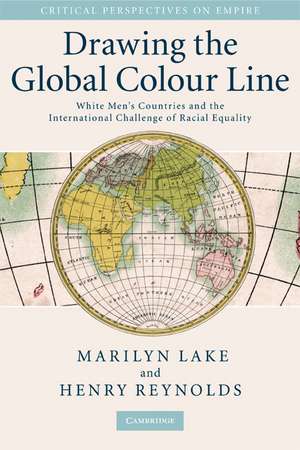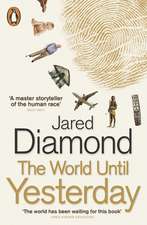Drawing the Global Colour Line: White Men's Countries and the International Challenge of Racial Equality: Critical Perspectives on Empire
Autor Marilyn Lake, Henry Reynoldsen Limba Engleză Paperback – 23 ian 2008
| Toate formatele și edițiile | Preț | Express |
|---|---|---|
| Paperback (1) | 227.65 lei 3-5 săpt. | |
| Cambridge University Press – 23 ian 2008 | 227.65 lei 3-5 săpt. | |
| Hardback (1) | 594.76 lei 6-8 săpt. | |
| Cambridge University Press – 23 ian 2008 | 594.76 lei 6-8 săpt. |
Din seria Critical Perspectives on Empire
- 9%
 Preț: 662.84 lei
Preț: 662.84 lei -
 Preț: 291.69 lei
Preț: 291.69 lei -
 Preț: 299.41 lei
Preț: 299.41 lei -
 Preț: 159.35 lei
Preț: 159.35 lei -
 Preț: 230.34 lei
Preț: 230.34 lei - 5%
 Preț: 219.29 lei
Preț: 219.29 lei -
 Preț: 232.91 lei
Preț: 232.91 lei - 9%
 Preț: 629.31 lei
Preț: 629.31 lei -
 Preț: 279.30 lei
Preț: 279.30 lei -
 Preț: 259.43 lei
Preț: 259.43 lei -
 Preț: 235.13 lei
Preț: 235.13 lei -
 Preț: 239.11 lei
Preț: 239.11 lei -
 Preț: 261.35 lei
Preț: 261.35 lei -
 Preț: 246.91 lei
Preț: 246.91 lei -
 Preț: 286.30 lei
Preț: 286.30 lei -
 Preț: 266.22 lei
Preț: 266.22 lei -
 Preț: 304.19 lei
Preț: 304.19 lei -
 Preț: 195.48 lei
Preț: 195.48 lei -
 Preț: 285.37 lei
Preț: 285.37 lei -
 Preț: 325.16 lei
Preț: 325.16 lei - 11%
 Preț: 584.90 lei
Preț: 584.90 lei -
 Preț: 361.54 lei
Preț: 361.54 lei - 11%
 Preț: 584.57 lei
Preț: 584.57 lei -
 Preț: 321.31 lei
Preț: 321.31 lei - 11%
 Preț: 626.27 lei
Preț: 626.27 lei -
 Preț: 324.79 lei
Preț: 324.79 lei -
 Preț: 222.86 lei
Preț: 222.86 lei -
 Preț: 208.89 lei
Preț: 208.89 lei -
 Preț: 286.51 lei
Preț: 286.51 lei -
 Preț: 326.92 lei
Preț: 326.92 lei -
 Preț: 285.54 lei
Preț: 285.54 lei
Preț: 227.65 lei
Nou
Puncte Express: 341
Preț estimativ în valută:
43.56€ • 45.63$ • 36.10£
43.56€ • 45.63$ • 36.10£
Carte disponibilă
Livrare economică 18 martie-01 aprilie
Preluare comenzi: 021 569.72.76
Specificații
ISBN-13: 9780521707527
ISBN-10: 0521707528
Pagini: 382
Dimensiuni: 152 x 227 x 23 mm
Greutate: 0.52 kg
Editura: Cambridge University Press
Colecția Cambridge University Press
Seria Critical Perspectives on Empire
Locul publicării:Cambridge, United Kingdom
ISBN-10: 0521707528
Pagini: 382
Dimensiuni: 152 x 227 x 23 mm
Greutate: 0.52 kg
Editura: Cambridge University Press
Colecția Cambridge University Press
Seria Critical Perspectives on Empire
Locul publicării:Cambridge, United Kingdom
Cuprins
Introduction; Part I. Modern Mobilities: 1. The coming man: Chinese migration to the Goldfields; Part II. Discursive Frameworks: 2. James Bryce's America and the negro problem; 3. Charles Pearson's prophecy: 'The day will come'; 4. Theodore Roosevelt: re-asserting racial vigour; 5. Imperial brotherhood or white: Gandhi in South Africa; Part III. Transnational Solidarities: 6. White Australia points the way; 7. Defending the Pacific slope; 8. White ties across the ocean: the Pacific Tour of the US Fleet; 9. The Union of South Africa: white men reconcile; Part IV. Challenge and Consolidation: 10. International conferences: enmity and amity; 11. Japanese alienation and imperial ambition; 12. Racial equality? Paris Peace Conference, 1919; 13. 'Segregation on a Large Scale': immigration restriction, 1920s; Part V. Towards Universal Human Rights: 14. Rights without distinction.
Recenzii
'This book by two of Australia's most respected historians is a tour de force. Weaving their narrative through global debates to do with race and human rights in the nineteenth and twentieth centuries, Lake and Reynolds have crafted a story that brings together - into one shared context - developments in Australia, the United States, China, Japan, Africa, India, and elsewhere. This is an exemplary exercise in transnational history.' Dipesh Chakrabarty, University of Chicago and author of Provincializing Europe
'Astonishing in its range of research, Drawing the Global Colour Line shows convincingly that farflung expressions of white solidarity entered a definitive new stage in the early twentieth century as a result of consultations, conferences and concerted actions among political-economic and intellectual elites in the Anglo-American settler colonial world. Such interactions, captured in all of their telling human detail, expressed hubris but also bespoke panic at the prospect that white supremacy was slipping away. By reinterpreting race, this critically important study reorients our understanding of the whole story of the twentieth century.' David Roediger, University of Illinois, author of Working Towards Whiteness
A work remarkable both for its international breadth and for its sensitivity to local 'particularity, is a model for the new transnational history. Marilyn Lake and Henry Reynolds expertly and imaginatively reconstruct how leading white intellectuals and politicians in turn of the century Australia, South Africa, the United States, and Great Britain fought demands for racial equality and jointly invented new doctrines of racial superiority to justify the maintenance and, in some cases, the reinvigoration of white privilege in every part of the world that Britain either controlled or in which it had once deposited its settlers. A powerful and sobering history, incisively and elegantly told.' Gary Gerstle, Vanderbilt University
“This exceptionally ambitious and important book confirms and gives fresh meaning to W. E. B. DuBois's famous declaration that the problem of the twentieth century was the 'problem of the colour line'. By tracing the efforts by ruling elites in the United States, Australia, and other Anglo settler states in the early twentieth century to forge self-proclaimed 'white men's countries' by means of racial segregation and immigration restrictions, Marilyn Lake and Henry Reynolds demonstrate that their assertions of 'whiteness' were a transnational phenomenon, responding to the threats that migrant labor, colonial nationalism, and other forces seemed to pose to the established order. Their rich and compellingly written work provides us with a model of how to write history that transcends the nation, and it speaks to issues that remain relevant today.' Dane Kennedy, Elmer Louis Kayser Professor of History and International Affairs, Department of History, George Washington University
'An exceptional study that could find a place even in the classroom, Drawing the Global Colour Line should command attention from historians, sociologists, and political scientists alike.' The Journal of Interdisciplinary History
'This is an important book, for colonial and imperial historians, world historians, Australian, New Zealand, South African, Canadian, US, Chinese and Japanese historians, and for scholars of human rights. Simply listing this scope of readership indicates the vast scope of the book and the multiple terrains across which it ranges. … This book is exemplary in demonstrating how interconnected history writing can transcend the limitations of, and add explanatory power to, both nationally focused and traditionally comparative histories.' The American Historical Review
'Drawing the Global Colour Line is a landmark work of transnational history. In the book two outstanding Australian historians – Marilyn Lake, who has been a leading figure in the development of feminist history, and Henry Reynolds, who has been pre-eminent in exploring the grim history of the colonial destruction of the aboriginals – break new ground, both methodologically and substantively. They provide us with a truly global history of racial politics at the end of the nineteenth and the beginning of the twentieth century. … Overall, this is a stunningly good book, written with a clarity and directness which is all too rare in contemporary academic prose.' The Journal of Global History
'… a truly unparalleled form of transnational history, one which operates from the archives of white settler colonies (North America included), only to reveal the provincialism of that vantage point, most notably by taking seriously the challenges posed by a variety of 'Asian' actors - from Chinese migrants to Japanese imperialists to Gandhi himself. This is a once-in-a-generation book, a must-read for students of empire, international politics, critical race studies and global history.' The International History Review
'Drawing the Global Colour Line forces us to reconceptualize the discursive and institutional development of whiteness as simultaneously nationally grounded and globally mobile. Scholars striving to extend the study of the geographies of empire, race, and whiteness, in particular, should find considerable inspiration in the approach marshaled so successfully herein.' H-HistGeog
'Astonishing in its range of research, Drawing the Global Colour Line shows convincingly that farflung expressions of white solidarity entered a definitive new stage in the early twentieth century as a result of consultations, conferences and concerted actions among political-economic and intellectual elites in the Anglo-American settler colonial world. Such interactions, captured in all of their telling human detail, expressed hubris but also bespoke panic at the prospect that white supremacy was slipping away. By reinterpreting race, this critically important study reorients our understanding of the whole story of the twentieth century.' David Roediger, University of Illinois, author of Working Towards Whiteness
A work remarkable both for its international breadth and for its sensitivity to local 'particularity, is a model for the new transnational history. Marilyn Lake and Henry Reynolds expertly and imaginatively reconstruct how leading white intellectuals and politicians in turn of the century Australia, South Africa, the United States, and Great Britain fought demands for racial equality and jointly invented new doctrines of racial superiority to justify the maintenance and, in some cases, the reinvigoration of white privilege in every part of the world that Britain either controlled or in which it had once deposited its settlers. A powerful and sobering history, incisively and elegantly told.' Gary Gerstle, Vanderbilt University
“This exceptionally ambitious and important book confirms and gives fresh meaning to W. E. B. DuBois's famous declaration that the problem of the twentieth century was the 'problem of the colour line'. By tracing the efforts by ruling elites in the United States, Australia, and other Anglo settler states in the early twentieth century to forge self-proclaimed 'white men's countries' by means of racial segregation and immigration restrictions, Marilyn Lake and Henry Reynolds demonstrate that their assertions of 'whiteness' were a transnational phenomenon, responding to the threats that migrant labor, colonial nationalism, and other forces seemed to pose to the established order. Their rich and compellingly written work provides us with a model of how to write history that transcends the nation, and it speaks to issues that remain relevant today.' Dane Kennedy, Elmer Louis Kayser Professor of History and International Affairs, Department of History, George Washington University
'An exceptional study that could find a place even in the classroom, Drawing the Global Colour Line should command attention from historians, sociologists, and political scientists alike.' The Journal of Interdisciplinary History
'This is an important book, for colonial and imperial historians, world historians, Australian, New Zealand, South African, Canadian, US, Chinese and Japanese historians, and for scholars of human rights. Simply listing this scope of readership indicates the vast scope of the book and the multiple terrains across which it ranges. … This book is exemplary in demonstrating how interconnected history writing can transcend the limitations of, and add explanatory power to, both nationally focused and traditionally comparative histories.' The American Historical Review
'Drawing the Global Colour Line is a landmark work of transnational history. In the book two outstanding Australian historians – Marilyn Lake, who has been a leading figure in the development of feminist history, and Henry Reynolds, who has been pre-eminent in exploring the grim history of the colonial destruction of the aboriginals – break new ground, both methodologically and substantively. They provide us with a truly global history of racial politics at the end of the nineteenth and the beginning of the twentieth century. … Overall, this is a stunningly good book, written with a clarity and directness which is all too rare in contemporary academic prose.' The Journal of Global History
'… a truly unparalleled form of transnational history, one which operates from the archives of white settler colonies (North America included), only to reveal the provincialism of that vantage point, most notably by taking seriously the challenges posed by a variety of 'Asian' actors - from Chinese migrants to Japanese imperialists to Gandhi himself. This is a once-in-a-generation book, a must-read for students of empire, international politics, critical race studies and global history.' The International History Review
'Drawing the Global Colour Line forces us to reconceptualize the discursive and institutional development of whiteness as simultaneously nationally grounded and globally mobile. Scholars striving to extend the study of the geographies of empire, race, and whiteness, in particular, should find considerable inspiration in the approach marshaled so successfully herein.' H-HistGeog
Descriere
This book studies the construction of self-styled white men's countries from South Africa, to North America and Australasia.













